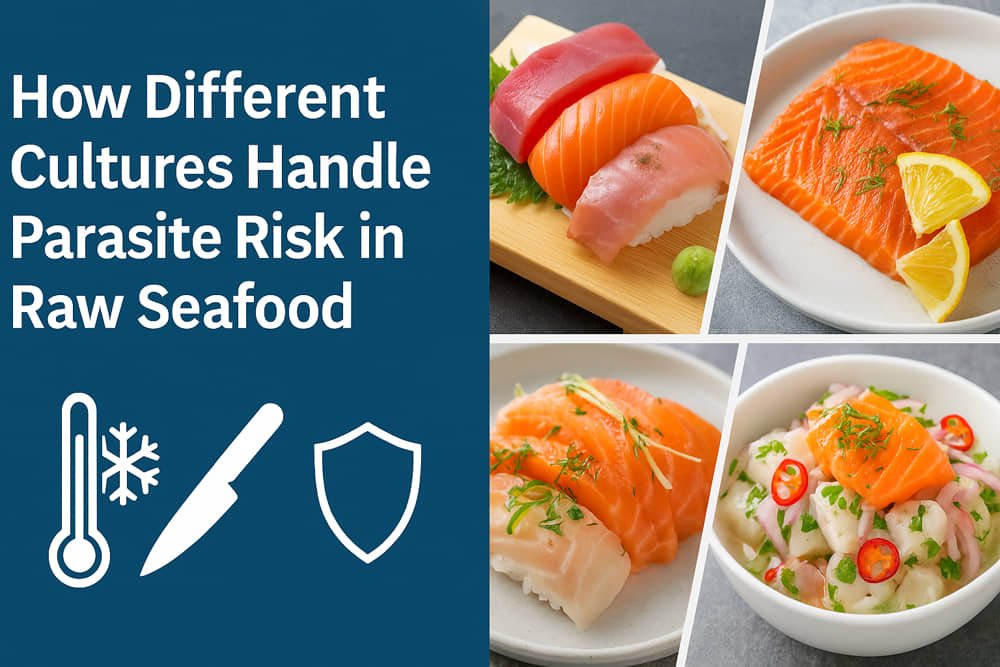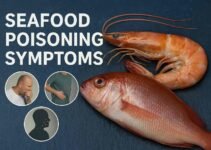Raw seafood is a global culinary staple—from Japan’s sashimi to Korea’s hoe, from Peru’s ceviche to Scandinavia’s cured herring. While the flavors and textures vary, one universal concern transcends cultural differences: the risk of parasites in uncooked fish. Organisms like Anisakis simplex, Diphyllobothrium latum, and Opisthorchis viverrini can enter the human digestive system through improperly prepared seafood, leading to serious health issues.
However, cultures with long-standing traditions of raw fish consumption have developed systematic methods to mitigate parasite risk. These include legal freezing standards, rapid gutting techniques, controlled aquaculture practices, and traditional preservation methods such as salting, fermenting, and acidic marination. Understanding how different countries and cuisines address this issue reveals not only food safety strategies but also insights into regional values, environmental conditions, and scientific regulation.
This article breaks down the specific parasite control practices in Japan, the Nordic countries, South Korea, and beyond—offering a comparative, entity-based look at how raw seafood can be enjoyed safely when guided by evidence-backed methods and cultural wisdom.
Contents
- 1 Why Are Parasites a Real Threat in Raw Seafood?
- 2 How Does Japan Handle Parasite Risks in Sushi and Sashimi?
- 3 What Do Nordic Countries Do to Make Raw Fish Safe from Parasites?
- 4 How Does South Korea Handle Raw Fish Safety in Dishes Like Hoe and Hwareo-hoe?
- 5 What International Standards (EU, US FDA) Govern Parasite Control in Raw Seafood?
- 6 What Traditional Preparation Methods Can Kill Parasites Without Freezing?
- 7 Which Types of Seafood Carry the Highest Risk and Should Be Avoided When Raw?
- 8 Can Traditional Methods Like Salting or Vinegar Soaking Replace Freezing?
- 9 How Do Techniques Like Immediate Gutting and Thin Slicing Help Prevent Infection?
- 10 Which Types of Seafood Carry the Highest Risk and Should Be Avoided When Raw?
Why Are Parasites a Real Threat in Raw Seafood?
Parasites pose a proven biological risk in raw seafood due to their ability to survive in uncooked fish and infect humans. These organisms use fish as intermediate hosts before entering the human digestive tract, where they can cause gastrointestinal or systemic symptoms. The risk is highest when seafood is consumed raw, marinated, or undercooked.
What Types of Parasites Are Commonly Found in Raw Fish?
The 4 most common parasites found in raw seafood are Anisakis simplex, Pseudoterranova decipiens, Diphyllobothrium latum, and Opisthorchis species.
- Anisakis simplex is a roundworm found in saltwater fish such as mackerel, cod, and herring.
- Pseudoterranova primarily infects cod and halibut and is visually larger than Anisakis.
- Diphyllobothrium, a tapeworm, thrives in freshwater fish like pike and perch.
- Opisthorchis, common in Southeast Asia, is linked to raw freshwater fish and causes liver fluke infections.
Each of these parasites has been documented in clinical studies to survive in inadequately frozen or raw fish products.
How Do These Parasites Enter the Human Body?
Parasites infect humans when contaminated raw seafood is consumed without proper freezing or preparation. Once ingested, larvae can penetrate the gastrointestinal lining, triggering immune responses such as eosinophilic granulomas or allergic reactions.
According to the World Health Organization (WHO), improperly handled raw seafood is a leading vector for anisakiasis in countries with high consumption rates, including Japan, Spain, and Chile.
How Does Japan Handle Parasite Risks in Sushi and Sashimi?
Japan controls parasite risks in raw seafood by enforcing strict freezing protocols and promoting seasonal consumption of low-risk fish. This two-tiered system includes government regulation and culturally embedded preparation techniques.
Are There Any Legal Requirements in Japan to Freeze Raw Fish?
Yes, Japanese health regulations require fish species with known parasite risks to be frozen at −20°C for 24 hours before being served raw.
This aligns with guidelines set by the Japanese Ministry of Health, Labour and Welfare and is strictly followed in professional kitchens and seafood markets. Fish that are farmed under controlled conditions or sourced from low-risk environments are exempt.
Farmed tuna, for instance, is usually fed parasite-free feed and kept in enclosed net pens, reducing exposure to wild parasite vectors, which makes freezing unnecessary.
Why Is Coastal Fish in Japan Considered Lower Risk?
Coastal and seasonal fish in Japan are considered safer because of their cold-water habitat and the short time between catch and consumption.
Japanese fishermen often gut the fish immediately on deck, minimizing the chance for parasites to migrate from the gut into muscle tissues. This method, known as ikejime, is culturally and commercially practiced, especially for high-end sashimi fish like sea bream (tai) or horse mackerel (aji).
What Do Nordic Countries Do to Make Raw Fish Safe from Parasites?
Nordic countries like Norway and Sweden mitigate parasite risks through mandatory freezing laws and traditional preparation methods that render parasites non-viable.
Why Does Norway Require Freezing Salmon Before It Can Be Eaten Raw?
Norwegian regulations require salmon intended for raw consumption to be frozen at −20°C for at least 24 hours, regardless of whether it is farmed or wild.
This mandate is enforced under European Commission Regulation (EC) No 853/2004, which is applied across the EU. Although most Norwegian salmon is farmed and raised in controlled conditions, the law maintains a uniform safety standard to prevent parasite transmission.
Do Traditional Preservation Methods Like Curing or Salting Kill Parasites?
Traditional methods such as salting, fermenting, or cold smoking can reduce parasite viability, but only when done at sufficient intensity and duration.
For example:
- Gravlax, a cured salmon dish, involves salting and refrigerating for several days, which lowers parasite survival rates.
- Surströmming, fermented Baltic herring, undergoes a long fermentation process that creates a highly acidic, anaerobic environment — hostile to most parasites.
However, these methods do not replace freezing standards and are generally paired with pre-freezing in commercial settings.
How Does South Korea Handle Raw Fish Safety in Dishes Like Hoe and Hwareo-hoe?
South Korea reduces parasite risks in raw seafood through rapid gutting, visual inspection, and sourcing from low-risk aquaculture environments. These steps are followed consistently in restaurants, fish markets, and domestic kitchens.
Do Korean Restaurants Inspect Fish for Parasites Before Serving?
Yes, Korean restaurants use visual inspection and rely on certified supply chains to minimize parasite exposure.
Professional chefs are trained to detect signs of parasite infection such as cysts or discoloration in fish fillets. Most raw fish served in restaurants is sourced from aquaculture farms where water temperature, feed, and health monitoring reduce the chances of parasitic infection.
The Korean Ministry of Food and Drug Safety (MFDS) issues guidance on parasite control in seafood preparation and enforces regular inspections at processing facilities and dining establishments.
Are There Specific Preparation Techniques That Lower Risk?
Korean fish handlers minimize parasite transmission by gutting fish immediately and slicing fillets thinly to expose larvae if present.
Many recipes also include steps like briefly soaking the fish in a mixture of vinegar and saltwater, which alters the tissue environment and may damage certain parasites’ viability. This approach is common in dishes like gulhoe (raw oyster) and gwangeo-hoe (flatfish sashimi).
What International Standards (EU, US FDA) Govern Parasite Control in Raw Seafood?
International food safety authorities like the European Union and the US FDA mandate specific freezing procedures to eliminate parasites in raw seafood.
What Are the Freezing Requirements for Raw Fish Served Without Cooking?
The US FDA requires raw fish to be frozen at −20°C (−4°F) for 7 days or −35°C (−31°F) for 15 hours to kill parasites.
These guidelines are outlined in the FDA Food Code and are mandatory for all food establishments serving raw or undercooked fish unless specific exemptions apply. The process is referred to as parasite destruction freezing.
In the European Union, similar rules are enforced under Regulation (EC) No 853/2004, requiring −20°C for at least 24 hours for wild-caught fish species intended to be eaten raw.
Are There Exceptions to These Freezing Rules?
Yes, both the FDA and EU allow exceptions for fish raised in parasite-free environments through aquaculture.
For example, farmed salmon raised on controlled pellet feed and without exposure to natural prey are exempt because they are not part of the parasite lifecycle. However, documentation and certification are required to prove the fish’s origin and risk status.
What Traditional Preparation Methods Can Kill Parasites Without Freezing?
Some traditional seafood preservation techniques such as fermentation, salting, or pickling can deactivate parasites, but only under scientifically proven conditions.
How Effective Are Fermentation, Salting, and Vinegar Curing in Killing Parasites?
Fermentation and strong salting at high concentrations can reduce or eliminate parasite activity, especially in long-duration processes.
For instance, Icelandic fermented shark (hákarl) is cured for 4–5 weeks and hung for 2–3 months, creating an ammonia-rich environment that is not survivable for parasites. Similarly, Peruvian ceviche, where fish is marinated in citrus acid for at least 15–30 minutes, can denature protein structures in some parasite larvae.
However, mild pickling or short-term marination, such as in quick gravlax or sushi rice vinegar, does not guarantee full parasite destruction and should be combined with prior freezing.
Can Early Gut Removal and Thin Slicing Prevent Parasite Migration?
Yes, immediate evisceration of fish upon capture significantly limits parasite movement from the gut into muscle tissues.
This technique, known as field dressing or ikejime in Japan, is commonly used in professional fishing and sashimi-grade seafood handling. Additionally, thin slicing exposes more surface area, which not only reveals visible parasites but also disrupts larval integrity if combined with acidic or salted environments.
Which Types of Seafood Carry the Highest Risk and Should Be Avoided When Raw?
Seafood species with a high prevalence of parasites—especially wild-caught marine and freshwater fish—should be frozen or avoided when eaten raw.
Are Wild-Caught Fish More Dangerous Than Farmed Fish?
Yes, wild-caught fish have a higher parasite burden than farmed fish due to their uncontrolled diet and exposure to the parasite lifecycle.
Wild fish ingest smaller infected prey, allowing parasites like Anisakis or Diphyllobothrium to mature within their tissues. According to a 2020 study published in Global Change Biology, wild fish have up to 283 times more parasite density than farmed equivalents.
By contrast, farm-raised fish such as Atlantic salmon or Japanese amberjack (hamachi) are fed sterile pellet feed and kept in controlled net pens, significantly reducing their exposure to parasite hosts.
Which Fish Species Are Most Frequently Infected with Anisakis?
Anisakis larvae are commonly found in herring, mackerel, cod, anchovies, and squid.
Among these, Pacific herring and Atlantic mackerel have the highest documented infection rates, particularly during their spawning seasons. Japanese health agencies routinely test saba (mackerel) for visible signs of larval movement before allowing its raw use in sushi restaurants.
Other at-risk species include blue whiting, hake, and wild-caught pollock, especially when sourced from temperate North Atlantic and Pacific waters.
Can Traditional Methods Like Salting or Vinegar Soaking Replace Freezing?
No, traditional methods such as salting or vinegar soaking are not consistently effective substitutes for freezing and should be treated as supplementary precautions.
What Is the Scientific Basis for These Traditional Methods?
Only when specific salt concentrations, temperatures, and exposure durations are met can traditional methods reliably kill parasites.
For example, the U.S. Department of Agriculture (USDA) indicates that salt levels above 20% and marination lasting over 7 days at low temperatures may kill Anisakis larvae. However, most home and restaurant recipes use lower salt percentages or shorter durations, which are insufficient for total deactivation.
Vinegar curing, commonly seen in dishes like Japanese shime saba, changes the pH of fish tissue but does not reach all areas of the fillet equally. Without prior freezing, this method is inadequate as a standalone safety measure.
How Do Techniques Like Immediate Gutting and Thin Slicing Help Prevent Infection?
Immediate gutting and precision slicing significantly reduce the risk of parasite migration and increase visibility of any present larvae.
Why Is Gutting Immediately After Catching Critical?
Parasites migrate from the digestive tract to muscle tissue within hours after the fish dies if not gutted.
By eviscerating the fish on-site, fishermen interrupt the lifecycle of parasites like Anisakis, which often start in the gastrointestinal tract. This method is standard practice in Japanese commercial fisheries and is supported by the Food and Agriculture Organization (FAO) as a critical control point in parasite prevention.
How Does Thin Slicing Contribute to Safer Consumption?
Thin slicing increases surface exposure, making it easier to detect, remove, or neutralize larvae during preparation.
This technique is used in Korean hoe, Japanese sashimi, and Peruvian tiradito, where the presentation style doubles as a safety function. Additionally, acidic marinades or dipping sauces are more effective on thinner cuts, enhancing both flavor and protective effect.
Which Types of Seafood Carry the Highest Risk and Should Be Avoided When Raw?
Seafood species with a high prevalence of parasites—especially wild-caught marine and freshwater fish—should be frozen or avoided when eaten raw.
Are Wild-Caught Fish More Dangerous Than Farmed Fish?
Yes, wild-caught fish have a higher parasite burden than farmed fish due to their uncontrolled diet and exposure to the parasite lifecycle.
Wild fish ingest smaller infected prey, allowing parasites like Anisakis or Diphyllobothrium to mature within their tissues. According to a 2020 study published in Global Change Biology, wild fish have up to 283 times more parasite density than farmed equivalents.
By contrast, farm-raised fish such as Atlantic salmon or Japanese amberjack (hamachi) are fed sterile pellet feed and kept in controlled net pens, significantly reducing their exposure to parasite hosts.
Which Fish Species Are Most Frequently Infected with Anisakis?
Anisakis larvae are commonly found in herring, mackerel, cod, anchovies, and squid.
Among these, Pacific herring and Atlantic mackerel have the highest documented infection rates, particularly during their spawning seasons. Japanese health agencies routinely test saba (mackerel) for visible signs of larval movement before allowing its raw use in sushi restaurants.
Other at-risk species include blue whiting, hake, and wild-caught pollock, especially when sourced from temperate North Atlantic and Pacific waters.
Raw seafood remains a celebrated culinary tradition across cultures—from hoe in South Korea to crudo in Italy. However, parasite risks are not hypothetical—they are documented and quantifiable. What differentiates safe consumption from hazardous practice lies in how each culture applies science-backed interventions like freezing, gutting, and high-salinity curing to mitigate these risks.
Those interested in preparing raw fish safely at home can refer to the guide on Safe Ways to Eat Raw Fish at Home, while readers curious about sourcing can explore How to Choose Sashimi-Grade Seafood. These resources delve further into best practices, supplier certifications, and parasite screening techniques, expanding this topic cluster into entities such as kitchen-level parasite control, raw seafood preparation checklists, and FDA-grade fish freezing standards.



